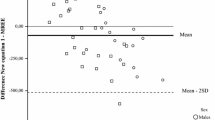Abstract
Objective: Outpatient treatment in restricted eating disorder: indirect calorimetry during dynamic monitoring. Design: A retrospective observational study. Subjects: Twenty seven women affected by restricted eating disorder (essentially anorexia nervosa) with a body mass index [weight (kg)/height (m2)] of 17.29±2.47 were studied. The sample was compared as itself control during rehabilitative way. Interventions: Fat mass (FM) and fat free mass (FFM) were determined by anthropometry technique. REE/day and respiratory quotient (RQ,VCO2/VO2) were measured by indirect calorimetry using a Calorimeter Vmax 29n-Sensor Medics-California. Skinfold thickness and circumferences were also measured. Arm muscle area (AMA) and fat area were calculated by formulas reported in Frisancho. Results: The data indicated a positive correlation between AMA, VO2/ml/min and resting energy expenditure (REE)/day values examined during follow-up of patients. The increase of these parameters indicated a good monitoring index correlated to a FFM recovery during psychonutritional rehabilitation. Conclusion: Indirect calorimetry represents a useful approach for determining REE and prescribing diets in these patients. Moreover, the combined use of anthropometric techniques allows to accurately assess and adjust therapy according to the patient’s progress. This study shows that restricted eating disorders are characterized by a recovery of FFM related to improvement of body weight and REE/day. On the contrary, the increase of AFA revealed a recovery of fat-metabolism (corresponding to RQ decrease) and lipid/carbohydrates oxidation improvement, only in the presence, at the same time, of O2 consumption increase.
Similar content being viewed by others
References
Fohlin L.: Body composition, cardiovascular and renal function in adolescent patients with anorexia nervosa. Acta Pediatr. Scand., 268 (Suppl), 7–20, 1977.
Hannan J., Cowen S., Freeman C., Mackie A., Shapiro C.M.: Assessment of body composition in anorexic patients. In: Yusumura S., Harrison J.E., Mc Neil K.G., Woodhead, Dilmanian F.A. (Eds), In vivo body composition study. Recent advances. New York, Plenum Press, 1990, pp. 149–155.
Krahn D.D., Rock C., Dechert R.E., Nair K.K., Hasse S.A.: Changes in resting energy expenditure and body composition in anorexia nervosa patients during refeeding. J. Am. Diet. Assoc., 93, 434–438, 1993.
Scalfi L., Di Biase G., Sapio C., Coltorti A., Contaldo F.: Bioimpedance analysis and resting energy expenditure in undernourished and refed anorectic patients. Eur. J. Clin. Nutr., 47, 61–67, 1993.
Nuñez C., Carbajal A., Moreiras O.: Refeeding efficacy on body composition in hospitalized patients with anorexia nervosa. Nutr. Res., 14, 1457–1463, 1994.
Probst M., Goris M., Vandereycken W., Van Coppenolle H.: Body composition in female anorexia nervosa patients. Br. J. Nutr., 76, 639–647, 1996.
Orphanidou C.I., McCargar L.J., Birmingham C.L., Belzberg A.S.: Changes in body composition and fat distribution after short-term weight gain in patients with anorexia nervosa. Am. J. Clin. Nutr., 65, 1034–1041, 1997.
Polito A., Cuzzolaro M., Raguzzini A., Censi I., Ferro-Luzzi A.: Body composition changes in anorexia nervosa. Eur. J. Clin. Nutr., 52, 655–662, 1998.
Shepard R.J.: Pathological disturbances of body composition. In: Lasker G.W., Mascie-Taylor C.G.N., Roberts D.F. (Eds), Body composition in biological anthropology. Cambridge, Cambridge University Press, 1991, pp. 226–241.
Probst M., Goris M., Vandereycken W., Van Coppenolle H.: Body composition of anorexia nervosa patients assessed by under water weighing and skinfold-thickness measurements before and after weight gain. Am. J. Clin. Nutr., 73, 190–197, 2001.
American Psychiatric Association. DSM IV: Diagnostic and statistical manual of mental disorder. Washington, D.C., American Psychiatric Association, 1994.
Lohman T.G., Roche A.F., Martorell R.: Manuale di riferimento per la standardizzazione antropometrica. EDRA, 1992.
Durnin J., Womersley J.: Body fat assessed from total body density and its estimation from skinfold thickness: measurements on 481 men and women aged from 16 to 72 years. Br. J. Nutr., 32, 77–97, 1981.
Frisancho A.R.: New norms of upper limbs fat and muscle areas for assessment of nutritional status. Am. J. Clin. Nutr., 34, 2540–2545, 1981.
Bishop A.: National Health and Nutrition Examination Survey (NHANES I). Am. J. Clin. Nutr., 34, 2530–2539, 1981.
Mifflin M.D., Jeor S.T., Hill L.A., S cott B.J., Daugherty S.A., Koh Y.O.: A new predictive equation for resting energy expenditure in healthy individuals. Am. J. Clin. Nutr., 51, 241–247, 1990.
De Cristofaro P.: Basi metodologiche dell’approccio psiconutrizionale. Tomo I: Fondamenti della valutazione pluridimensionale. Chapter 6-8. Firenze, SEE, 2002.
Godart N., Atger F., Perdereau F., Agman G., Rein Z., Corcos M., Jeammet P.: Treatment of adolescent patients with eating disorders: Description of a psychodynamic approach in clinical practice. Eating Weight Disord., 9, 224–227, 2004.
Polito A., Fabbri A., Ferro-Luzzi A., Cuzzolaro M., Censi L., Ciarapica D., Fabbrini E., Giannini D.: Basal metabolic rate in anorexia nervosa: relation to body composition and leptin concentration. Am. J. Clin. Nutr., 71, 1495–1950, 2000.
De Zwaan M., Aslam Z., Mitchell J.E.: Resarch on energy expenditure in individuals with eating disorders: A review. Int. J. Eat. Disord., 31, 361–369, 2002.
Schebendach J.: The use of indirect calorimetry in the clinical management of adolescents with nutritional disorders. Adolesc. Med., 14, 77–85, 2003.
Author information
Authors and Affiliations
Corresponding author
Rights and permissions
About this article
Cite this article
Dragani, B., Malatesta, G., Di Ilio, C. et al. Dynamic monitoring of restricted eating disorders by indirect calorimetry: a useful cognitive approach. Eat Weight Disord 11, e9–e14 (2006). https://doi.org/10.1007/BF03327746
Received:
Accepted:
Published:
Issue Date:
DOI: https://doi.org/10.1007/BF03327746




